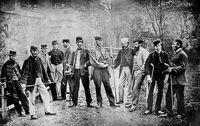Annotation:Links of Leith: Difference between revisions
No edit summary |
No edit summary |
||
| Line 3: | Line 3: | ||
<p><font face="garamond, serif" size="4"> | <p><font face="garamond, serif" size="4"> | ||
'''LINKS OF LEITH.''' Scottish, Reel. A Mixolydian. Standard tuning (fiddle). AAB. John Glen (1891) finds the earliest printing of the tune in Robert Bremner's collection. Links are uneven sandy, grass-covered ground near Scottish coasts, and golf was played on the Links of Leith [http://en.wikipedia.org/wiki/Leith_Links] from very early times (they were also the site of sieges and hangings!). King James 1V of Scotland was a golfer and records confirm that he purchased balls and clubs for "the playing of goufe at Leithe." Perhaps the most interesting match took place in 1681 when the first unofficial challenge took place between the Duke of York and his partner, John Patersone, and two English noblemen, who had maintained an English provenance for the game. Patersone was a poor shoemaker but came from a long line of golfers, and is said to have made leather-covered golf balls in the course of his trade. Of course, the match garnered much public interest, and on the day of the event a large crowd gathered to view the spectacle with much side-betting on the outcome. The Duke and the shoemaker won handily and the Duke magnanimously gave the lions share of the winnings to the poor tradesman. Patersone wisely invested his money in building a 'stylish' house in the Cannongate district of Edinburgh, installing above the entrance his family crest-a hand grasping a golf club with the inscription "Far and Sure." The house still stands and is known as Golfer's Land. | '''LINKS OF LEITH.''' Scottish, Reel. A Mixolydian. Standard tuning (fiddle). AAB. John Glen (1891) finds the earliest printing of the tune in Robert Bremner's collection. Links are uneven sandy, grass-covered ground near Scottish coasts, and golf was played on the Links of Leith [http://en.wikipedia.org/wiki/Leith_Links] from very early times (they were also the site of sieges and hangings!). King James 1V of Scotland was a golfer and records confirm that he purchased balls and clubs for "the playing of goufe at Leithe." Perhaps the most interesting match took place in 1681 when the first unofficial challenge took place between the Duke of York and his partner, John Patersone, and two English noblemen, who had maintained an English provenance for the game. Patersone was a poor shoemaker but came from a long line of golfers, and is said to have made leather-covered golf balls in the course of his trade. Of course, the match garnered much public interest, and on the day of the event a large crowd gathered to view the spectacle with much side-betting on the outcome. The Duke and the shoemaker won handily and the Duke magnanimously gave the lions share of the winnings to the poor tradesman. Patersone wisely invested his money in building a 'stylish' house in the Cannongate district of Edinburgh, installing above the entrance his family crest-a hand grasping a golf club with the inscription "Far and Sure." The house still stands and is known as Golfer's Land. | ||
[[File:linksofleith.jpg|200px|thumb|left|Professional golfers at a tournament on Leith Links, May, 1867]] | |||
<br> | <br> | ||
<br> | <br> | ||
Revision as of 03:20, 29 October 2012
Back to Links of Leith
LINKS OF LEITH. Scottish, Reel. A Mixolydian. Standard tuning (fiddle). AAB. John Glen (1891) finds the earliest printing of the tune in Robert Bremner's collection. Links are uneven sandy, grass-covered ground near Scottish coasts, and golf was played on the Links of Leith [1] from very early times (they were also the site of sieges and hangings!). King James 1V of Scotland was a golfer and records confirm that he purchased balls and clubs for "the playing of goufe at Leithe." Perhaps the most interesting match took place in 1681 when the first unofficial challenge took place between the Duke of York and his partner, John Patersone, and two English noblemen, who had maintained an English provenance for the game. Patersone was a poor shoemaker but came from a long line of golfers, and is said to have made leather-covered golf balls in the course of his trade. Of course, the match garnered much public interest, and on the day of the event a large crowd gathered to view the spectacle with much side-betting on the outcome. The Duke and the shoemaker won handily and the Duke magnanimously gave the lions share of the winnings to the poor tradesman. Patersone wisely invested his money in building a 'stylish' house in the Cannongate district of Edinburgh, installing above the entrance his family crest-a hand grasping a golf club with the inscription "Far and Sure." The house still stands and is known as Golfer's Land.

Around the time Bremner published his collection the first clubhouse was erected on the Links. Previously, in 1744, the Edinburgh town council had recognized the popularity of the game by awarding a silver club to be given each year to the winner of a competition played according to the rules set up by the Gentlemen Golfers. In the 19th century the association and the grounds deteriorated, with interest moving to other golfing venues, and today no trace of the Links exists.
Source for notated version:
Printed sources: Bremner (Scots Reels), 1757; p. 57.
Recorded sources:
Back to Links of Leith
